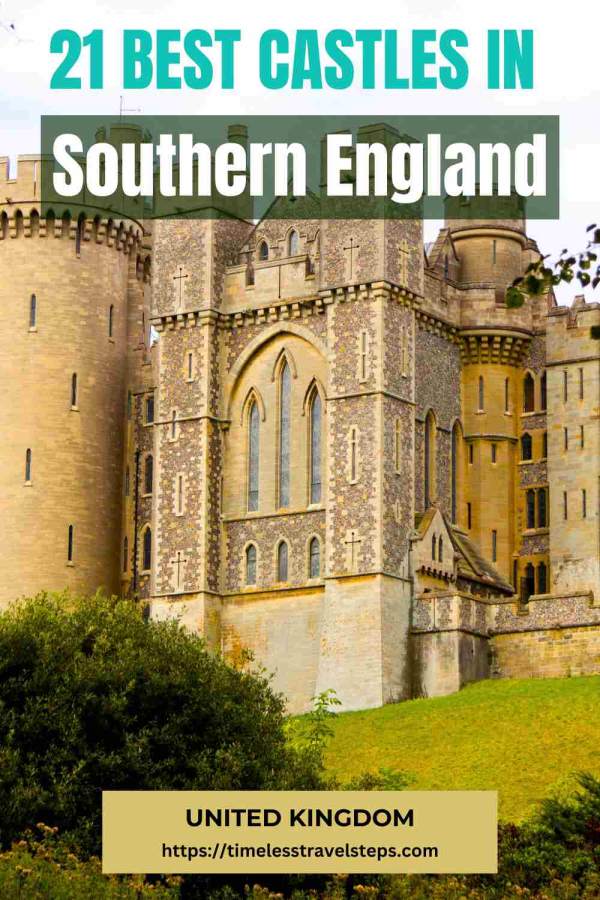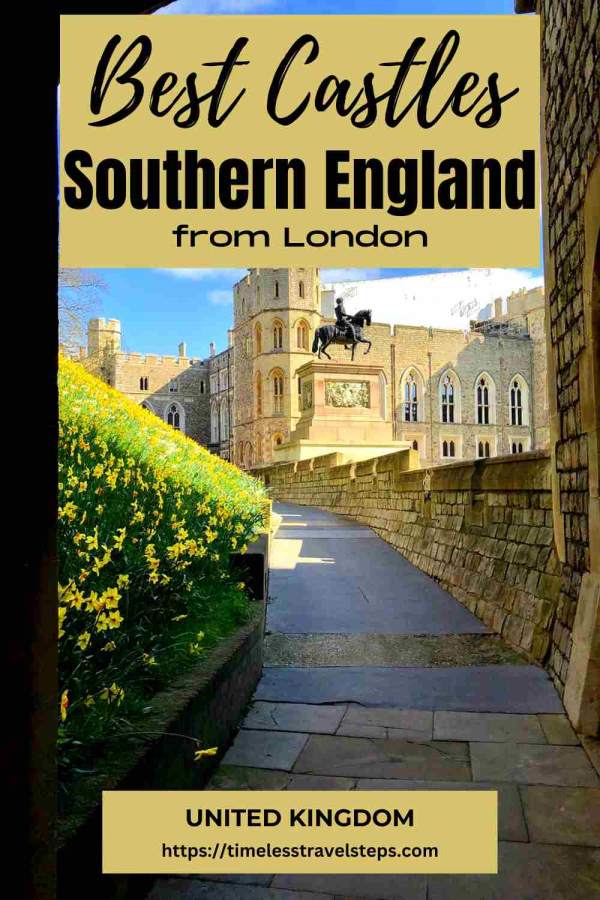Best Castles in Southern England to Visit from London
21 min readEngland, a land steeped in the rich tapestry of knights, castles, and tales that seem plucked from the pages of a fairytale, ignites the imagination with visions of princes, kings, and legendary battles. Among these, the best castles in Southern England stand as majestic landmarks, each telling a unique story of a storied past. This...
The post Best Castles in Southern England to Visit from London appeared first on Timeless Travel Steps.
England, a land steeped in the rich tapestry of knights, castles, and tales that seem plucked from the pages of a fairytale, ignites the imagination with visions of princes, kings, and legendary battles. Among these, the best castles in Southern England stand as majestic landmarks, each telling a unique story of a storied past.
This storied country, where history is etched into every hillside and echoed in the corridors of grand castles, invites you to step into a world where the echoes of chivalry and the whispers of bygone eras are as real as the stones that build its ancient fortresses. England’s historical landscape, particularly in the south, is a vivid tableau that stirs the soul, beckons the curious, and enchants the heart with its timeless legacy.
I have visited many English castles on day trips over the years as I live within a stone’s throw of London, England. In this post, I have handpicked the very best of the fairytale castles in Southern England, gems of history and beauty that beckons for exploration. There is a castle here for each of you, no matter if you’re a history buff, a lover of architectural beauty, or simply in search of a memorable day trip from London.
These castles are a treasure trove waiting to be explored, accessible by a car or train ride away from London, inviting you to step into a world where history and legend intertwine. Some castles are included as part of an excursion from London, and I’ve offered these options also.
Timeless Travel Steps is supported by our readers. If you purchase through an affiliate link on my site, at no cost to you, I may earn a commission from qualifying purchases. Please read our Disclosure.
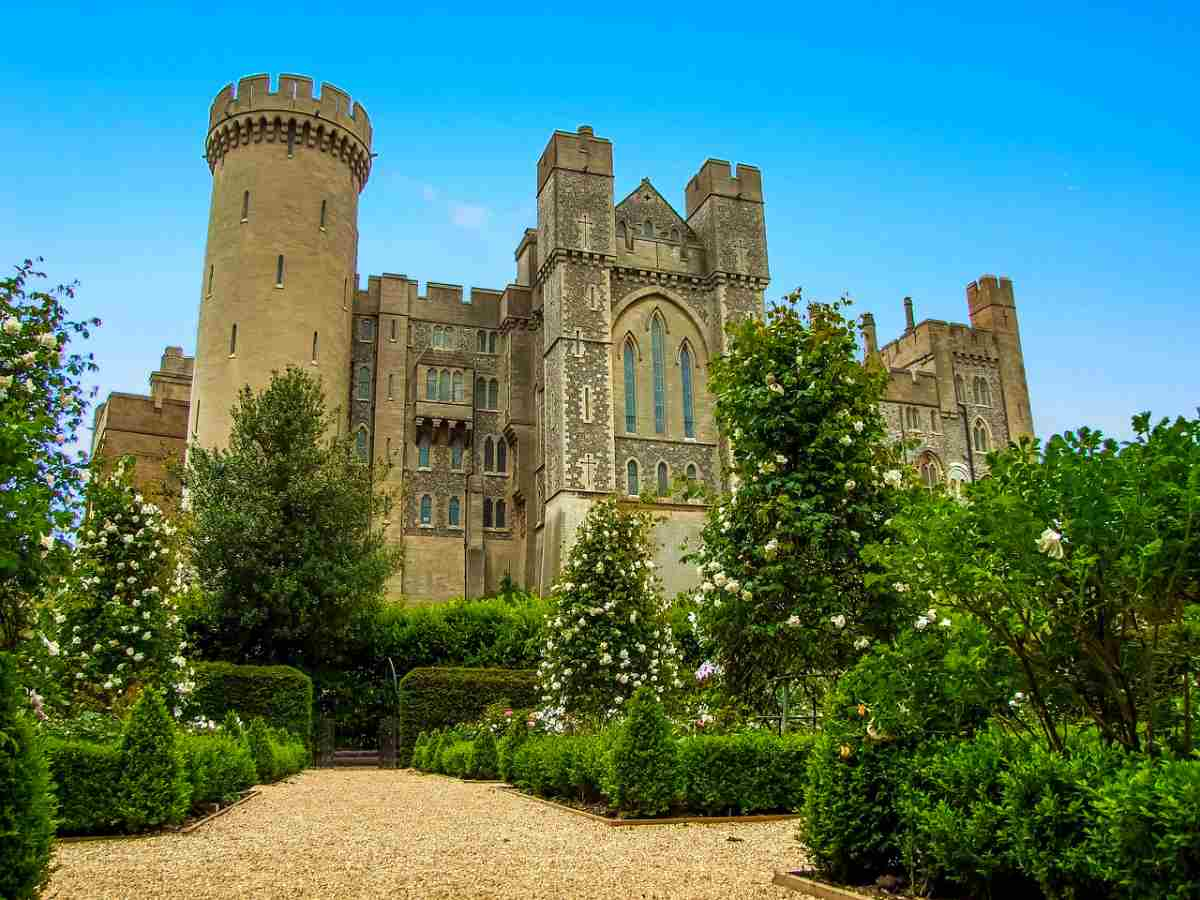
🚗 Need a Car to Explore the Castles in Southern England? Hire one Here.
🚆 Love Train Travel? Check Schedules + Get Your Train Tickets from London Here.
🚍 Prefer Someone Else to Do Driving For You? Check Options Here.
⛬ Enjoy Discovering Historic Sites? English Heritage Membership is Your Freedom to Explore > UK Residents Here; Overseas Visitors Here.
🏨 Find a Great Place to Stay in London.
21 Best Fairytale Castles in Southern England
Southern England, a region, encompassing the South East and South West of England, is dotted with an array of castles, each narrating a tale as unique as the stones that built them. From Windsor Castle, a royal home steeped in centuries of history, to the strategic Dover Castle in the East, which once stood as a defensive bulwark under Henry VIII, represent a diverse array of architectural marvels.
In the South East of England, castles like Bodiam Castle and Arundel Castle rise from the landscape as symbols of medieval might and noble grandeur. Heading towards the South West, you’ll encounter different stories, echoed in the walls of manor houses and fortified residences like Broughton Castle.
Each castle, whether it’s the stately home of Hever Castle, the Tudor elegance of Leeds Castle, or the strategic fortress of Carisbrooke Castle, offers a glimpse into a past era. The gardens of these castles, as much a part of their history as the turrets and keeps, provide a serene backdrop, enhancing their appeal.
Uncover the stories of these magnificent castles, and the families that called them home. Castles like Highclere Castle, a country house famed for its role in the television series “Downton Abbey,” and Herstmonceux Castle, blend historical significance with contemporary charm. These castles, along with others in Southern England, have been preserved as part of the country’s rich heritage. They stand as a testament to the architectural and historical diversity that has shaped England over centuries.
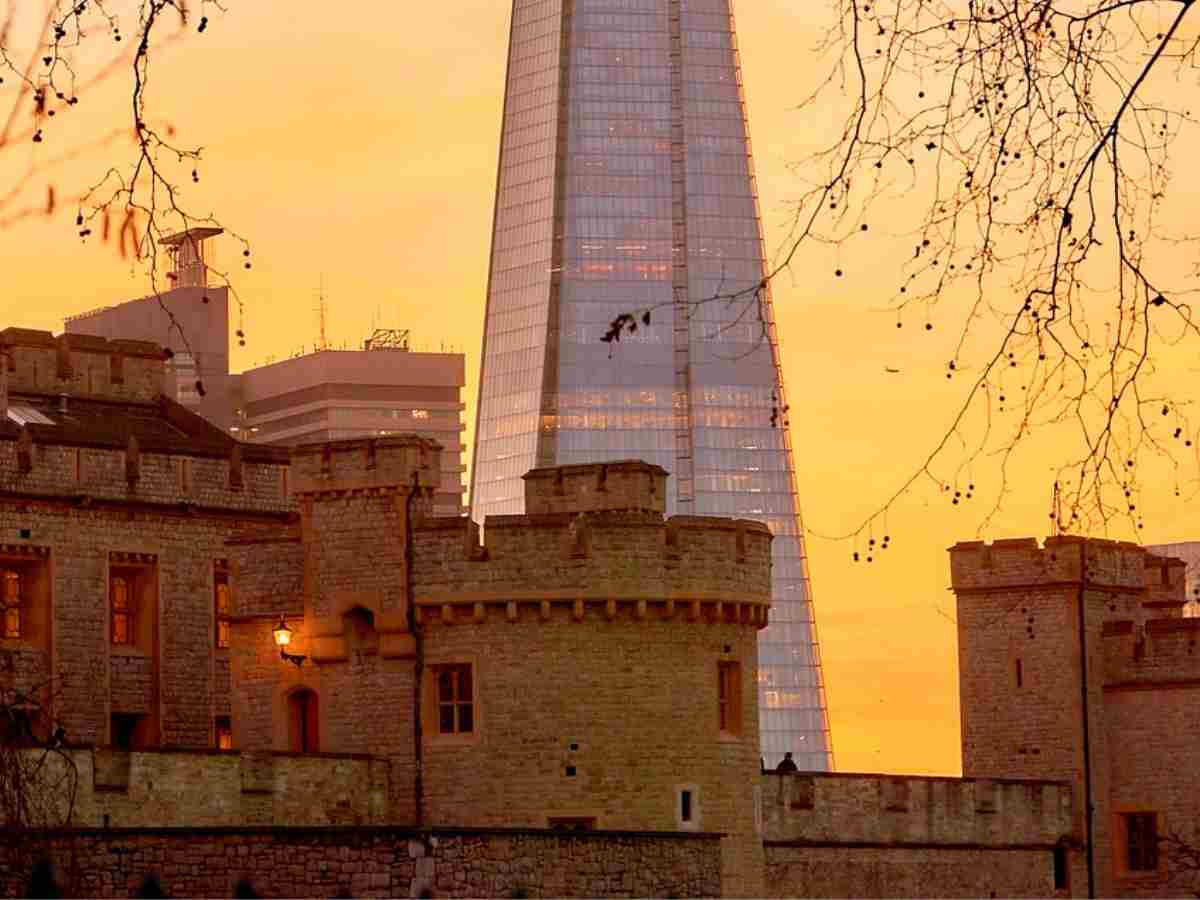
1. Arundel Castle, Sussex
Arundel Castle, located in Sussex, is a monumental piece of English history. Founded on Christmas Day in 1067 by Roger de Montgomery, it’s one of England’s longest continuously inhabited country houses. The castle beautifully encapsulates medieval and Gothic architectural styles, a reflection of its evolution over centuries. The castle retains many original Norman features, including the Norman Keep, Medieval gatehouse, and Barbican, making it a living museum of architectural history.
Why Visit: It offers a unique journey through England’s medieval past, with its grand rooms and exquisite art collections. The grounds feature immaculately maintained gardens, providing a tranquil retreat. A variety of events, including historical reenactments and medieval tournaments, are added to the castle’s vibrant atmosphere.
Ownership and Management: Arundel Castle’s history is deeply intertwined with the lineage of the Dukes of Norfolk, who have played a pivotal role in England’s history, have owned Arundel Castle for over a millennium.
How to Visit:📍Arundel Castle, Sussex: BN18 9AB
By car: the journey from London takes approximately 1 hour and 50 minutes, via A3 and A283, offering a scenic drive through the English countryside.
By Train: For those preferring public transport, a train journey from London Victoria Station to Arundel takes about 1 hour and 30 minutes.
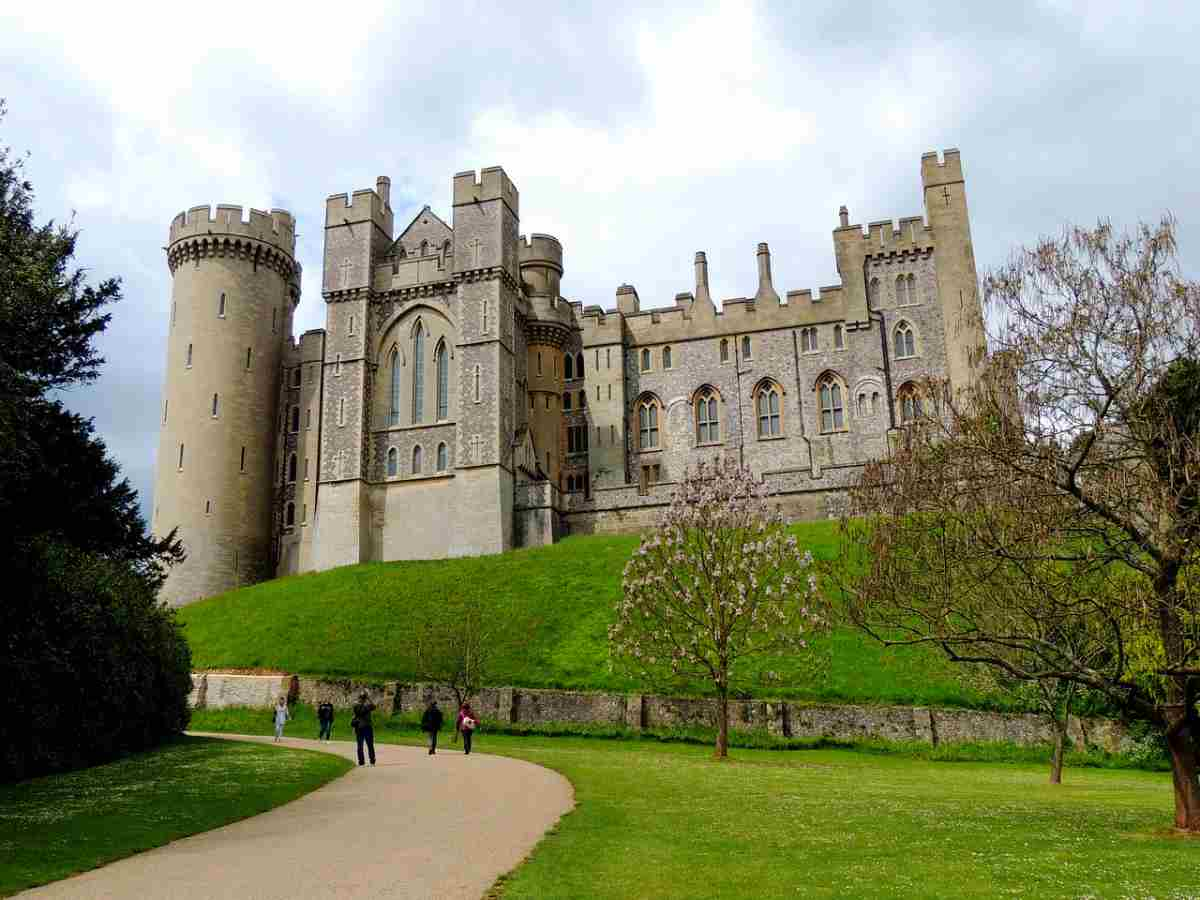
2. Bodiam Castle, East Sussex
Bodiam Castle in East Sussex is a quintessential medieval fortress, founded in 1385 by Sir Edward Dalyngrigge, a knight of Edward III. Constructed on a former Saxon site, it was intended to defend against French invasion during the Hundred Years’ War.
Why Visit: Despite being a ruin today, the castle is renowned for its architectural features typical of the late medieval period, including a moat, battlements, and a well-preserved gatehouse. It offers a glimpse into the life and times of medieval 14th century England. The castle’s rural setting in the 1066 Country provides a peaceful contrast to the hustle and bustle of city life, making it a favourite among those seeking a historical and scenic escape.
Ownership and Management: Bodiam Castle is presently under the stewardship of the National Trust, a UK organization dedicated to preserving historic and natural places, allowing visitors to appreciate its historical significance.
How to Visit:📍Bodiam Castle, East Sussex: TN32 5UA
By Car: Bodiam Castle is accessible from London by a 2-hour car journey via A2.
By Train: Alternatively, visitors can travel by train from London Charing Cross Station to Robertsbridge Station, followed by a short taxi ride.
READ: A Fun Day Out in Bodiam: Guide to the Best 9 Things to Do
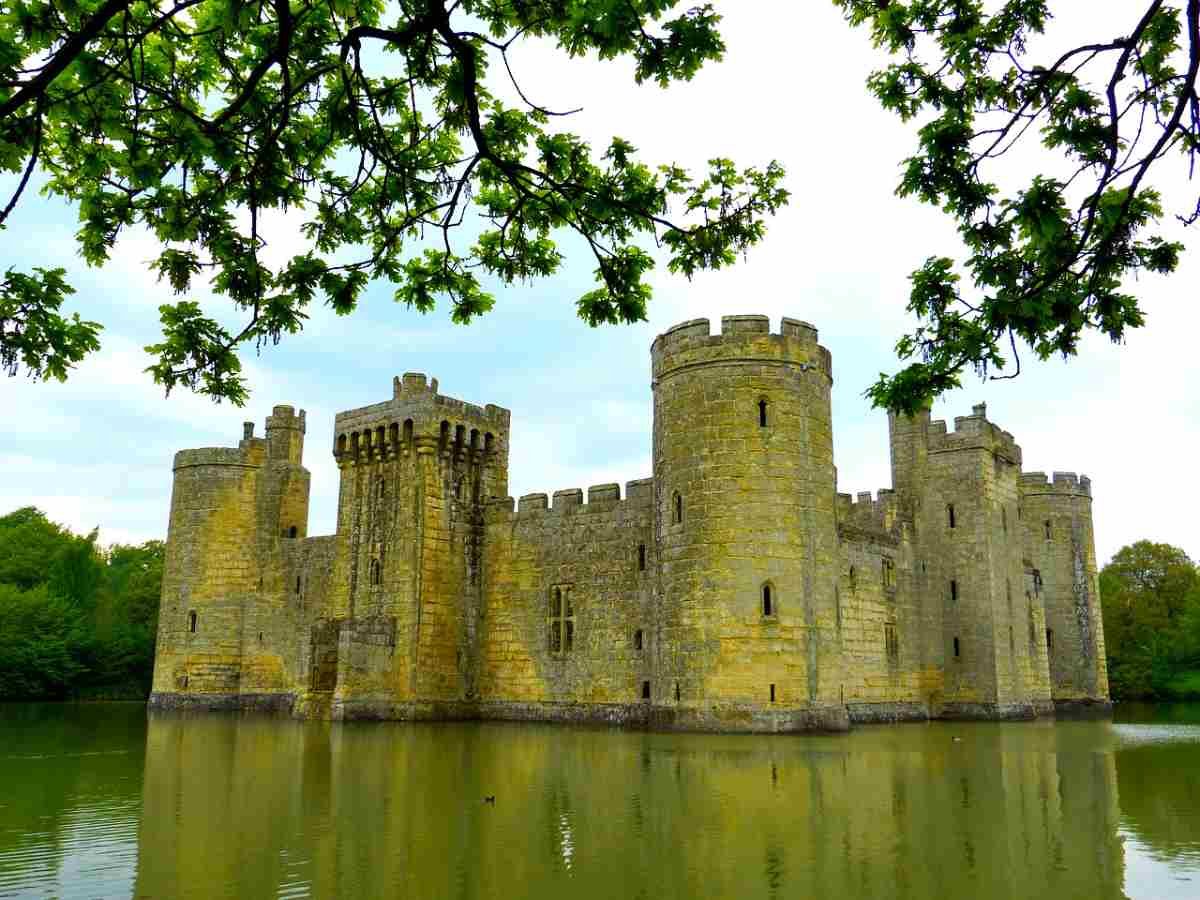
3. Broughton Castle in Oxfordshire
Often described more accurately as a fortified manor house rather than a battle-ready castle, Broughton was built in 1300 by Sir John de Broughton. Surrounded by a wide moat and set amidst picturesque gardens, the castle’s architecture predominantly dates back to the 1550s.
Why Visit: This idyllic estate, with its blend of medieval and 16th-century styles, is reflective of England’s rich architectural heritage and provides a fascinating insight into the country’s feudal past. The surrounding gardens are beautifully maintained, offering a tranquil setting for leisurely exploration.
Ownership and Management: Since 1447, it has been the home of the Barons Saye and Sele, and their family lineage continues to reside there. The castle remains privately owned by the Fiennes family, descendants of the Barons Saye and Sele.
How to Visit:📍Broughton Castle, Oxfordshire: OX15 5EB.
By Car: Broughton Castle is situated near Banbury in Oxfordshire, around a 1 hour and 30-minute drive from London. The journey offers scenic views of the English countryside.
By Train: For public transport users, trains run from London Marylebone to Banbury, followed by a short taxi ride to the castle.
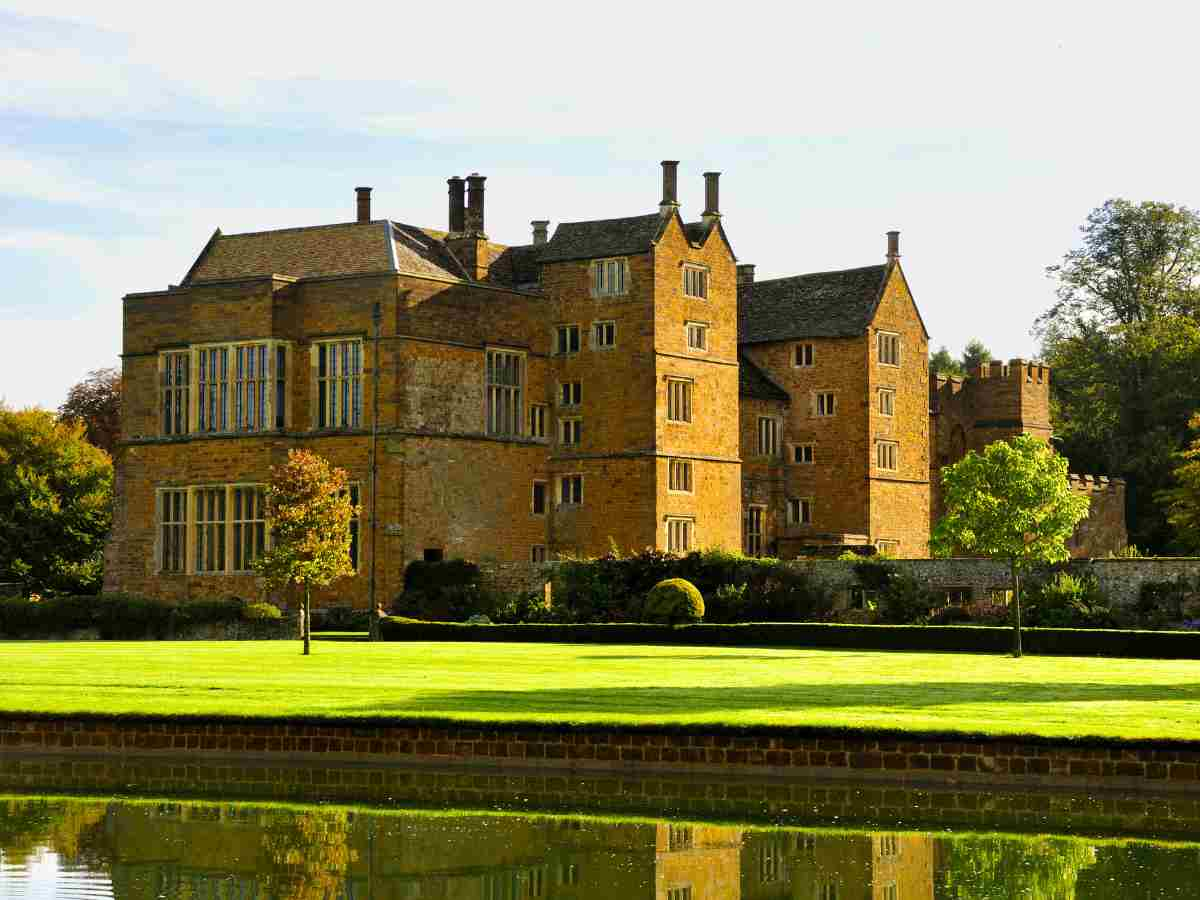
4. Deal Castle, Kent, Southern England
Deal Castle stands as a remarkable example of Tudor military architecture. Built in 1539 by Henry VIII, it forms part of a chain of coastal forts constructed as a defense against potential invasion from continental Europe. Characterized by its unique circular design and rounded bastions, Deal is the largest and most elaborate of Henry VIII’s coastal forts. It played a vital role in England’s coastal defense, including during the Napoleonic Wars, and remarkably withstood a three-month siege during the Second Civil War.
Why Visit: Discover the world of Tudor military engineering, and 16th-century defensive strategies. Explore the storerooms, captain’s residence, the bastions, and Henry VIII’s obsession with security and defense. Its coastal location provides picturesque views, making it a perfect blend of historical intrigue and natural beauty.
Ownership and Management: Currently managed by English Heritage, Deal Castle is preserved as an important historical site.
How to Visit:📍Deal Castle, Kent: CT14 7BA
By Car: Deal Castle is situated in the town of Deal, Kent, along the southeast coast of England. The journey from London to Deal is about 2 hours by car, offering a scenic route along the English coastline.
By Train: Alternatively, you can take a train from London to Deal, which is a convenient and enjoyable way to travel.
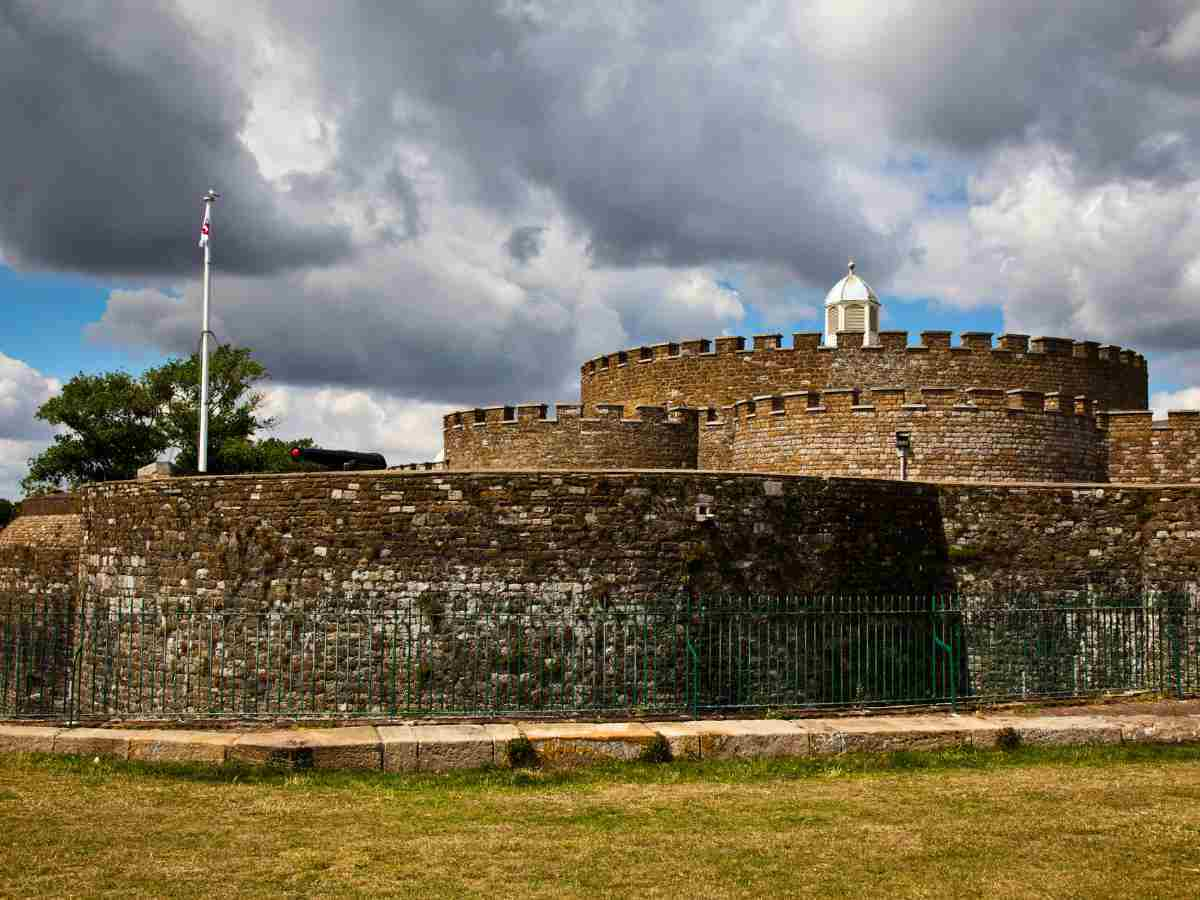
5. Guildford Castle, Surrey, Southern England
Situated in Surrey, Guildford Castle is a medieval structure with origins tracing back to the Norman Conquest. Initially constructed as a motte and bailey castle in the 11th century, it was later rebuilt in stone in the 1130s, marking a significant phase in its development.
The Great Keep, added under the orders of Henry II, is a highlight of the castle’s architecture. Over the centuries, Guildford Castle transitioned from a royal residence to a county jail before its decline.
Why Visit: Visiting Guildford Castle in southern England offers an insightful glimpse into medieval English history. The castle’s preserved Great Keep invites exploration, providing panoramic views of Guildford from its top. The castle grounds, now beautifully maintained as public gardens, offer a peaceful retreat.
Ownership and Management: Guildford Castle is managed by the Guildford Borough Council.
How to Visit:📍Guildford Castle, Surrey: GU1 3SX
By car: It’s approximately an hour’s drive, via A3, making it an easy day trip.
By Train: Frequent trains run from London Waterloo to Guildford, with the castle being a short walk from the station.
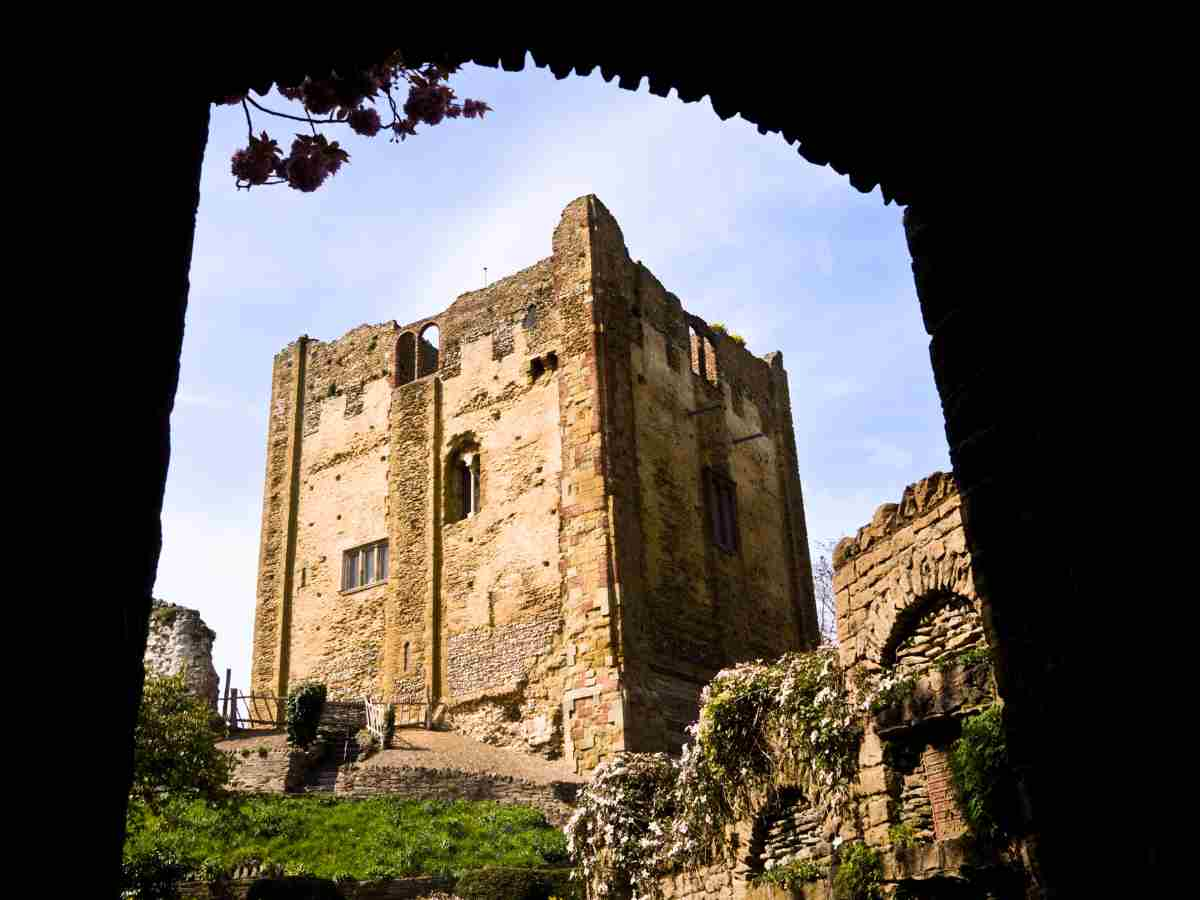
6. Herstmonceux Castle, East Sussex, Southern England
Herstmonceux Castle symbolises the grandeur of 15th-century architecture. Built in 1441 by Sir Roger Fiennes, this majestic brick-built moated castle is one of the earliest examples of a brick building of significant size in England.
Originally a Tudor-style country home, Herstmonceux was the largest private residence in England at its time, reflecting the wealth and status of its owner. The castle underwent renovations in the 17th century and again in the 20th century after falling into disrepair. Today, it is the site of the Study Centre for Queen’s University, Canada.
Why Visit: The castle’s interior, though not always open to the public, offers a glimpse into the life of Tudor nobility. The castle is surrounded by 550 acres of woodland and formal Elizabethan gardens. These grounds provide an idyllic setting for exploration and relaxation.
Ownership and Management: Currently, it is owned by Queen’s University, Canada, and serves as an international study centre.
How to Visit:📍Herstmonceux Castle, East Sussex: BN27 1RN
By car: The journey takes approximately 2 hours from London via A2.
By Train: There are also public transport options available, including trains from London to nearby stations, followed by a short taxi ride.
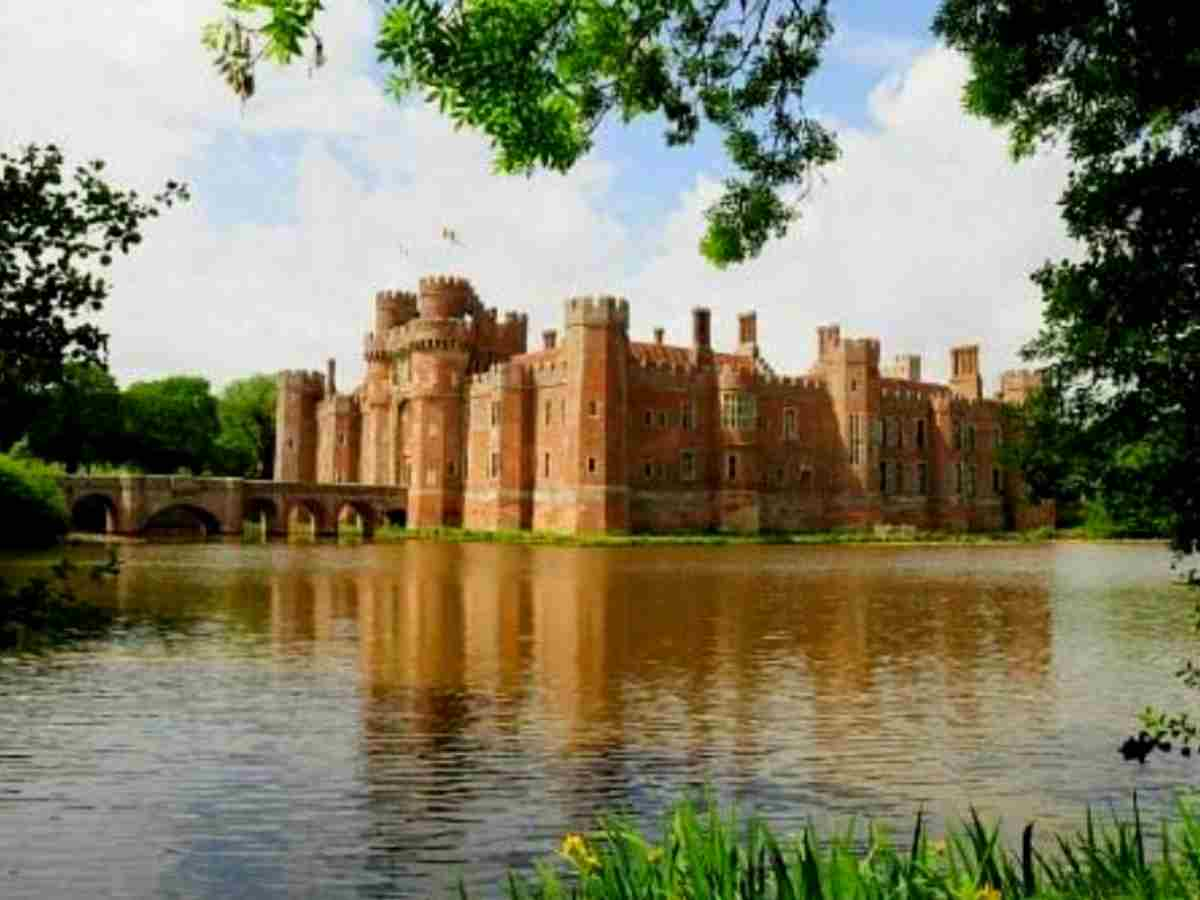
7. Highclere Castle, Hampshire, Southern England
Located in Hampshire, Highclere Castle is a historic estate with roots dating back to 749 AD. The current Jacobethan-style country house, set within a 5,000-acre estate with a park designed by Capability Brown, was built in the 19th century by architect Charles Barry.
Highclere Castle gained widespread fame as the filming location for the TV series “Downton Abbey.” The castle’s history intertwines with the lives of the aristocratic Carnarvon family, who have resided there since the late 17th century, and it showcases a remarkable collection of art and antique furnishings.
Why Visit: Visitors to Highclere Castle can enjoy a range of experiences, from exploring the opulent state rooms and bedrooms showcased in “Downton Abbey” to strolling through the beautifully landscaped gardens and woodlands.
Ownership and Management: The 8th Earl and Countess of Carnarvon currently own and manage Highclere Castle.
How to Visit: 📍 Highclere Castle, Hampshire: RG20 9RN
By Car: Situated about 112.6 kilometers (70 miles) west of London, Highclere Castle is accessible by a 1 hour and 30-minute drive from the city via M4.
By Train: Public transport options include a train from London Paddington to Newbury, followed by a short taxi ride to the castle.
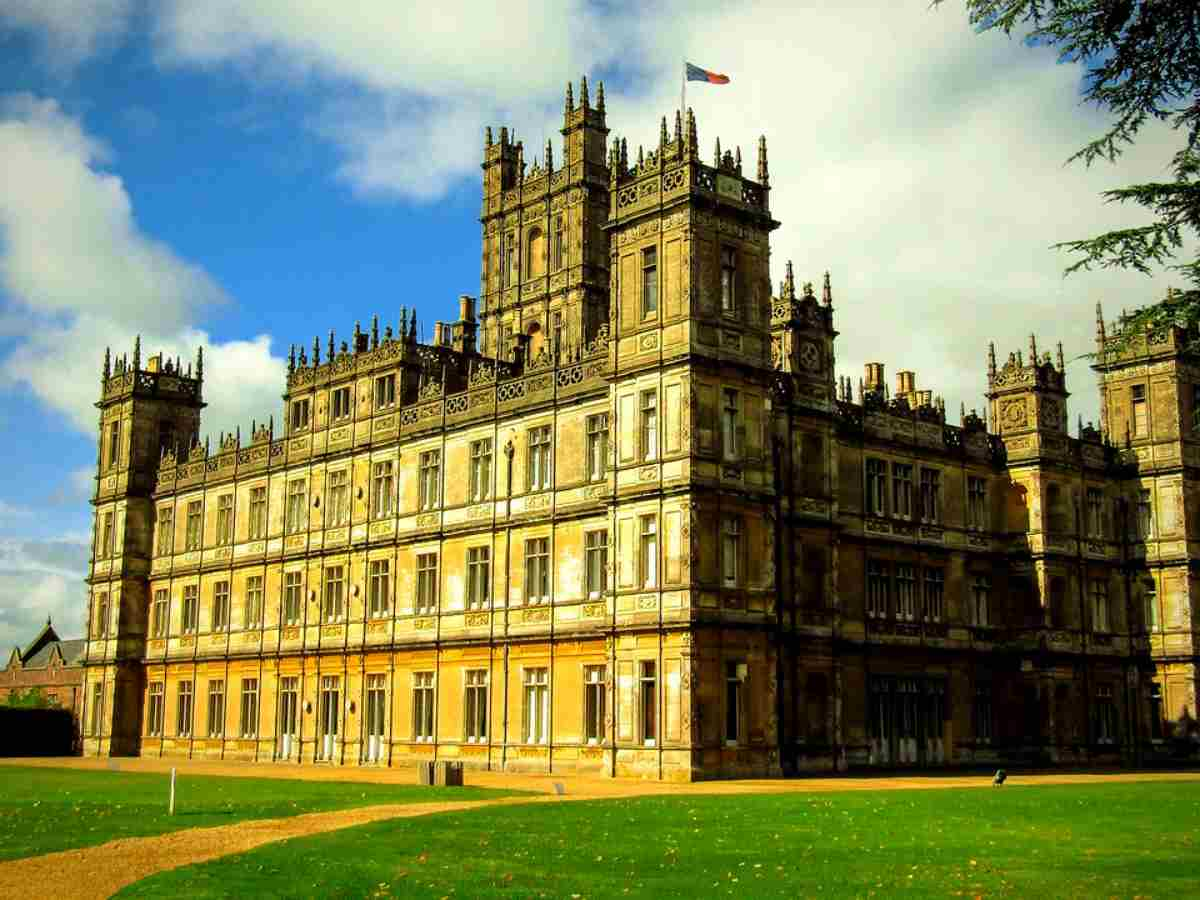
8. Kenilworth Castle, Warwickshire, Southern England
Kenilworth Castle, located in Warwickshire, has a storied history spanning over 900 years. Originally a medieval fortress built by the Normans, the castle is most famous for its connections to Queen Elizabeth I and Robert Dudley, Earl of Leicester. The castle’s remarkable features include the Norman Keep, Tudor Gatehouse, and Leicester’s Building.
Why Visit: The castle’s extensive ruins are ideal for exploration, offering insights into the life of the Tudor nobility. The recreated Elizabethan Garden, based on Dudley’s original design, is a highlight, transporting visitors back to the 16th century with its vibrant plants and elaborate fountains. The castle’s setting in the Warwickshire countryside adds to its allure, providing a scenic backdrop for a journey through history.
Ownership and Management: English Heritage currently manages Kenilworth Castle and Elizabethan Garden.
How to Visit: 📍Kenilworth Castle and Elizabethan Garden, Warwickshire: CV8 1NG
By Car: The castle is about a 2-hour drive from London via M40.
By Train: Public transport options include a train to the nearby Coventry or Leamington Spa stations, followed by a short taxi or bus ride to the castle.
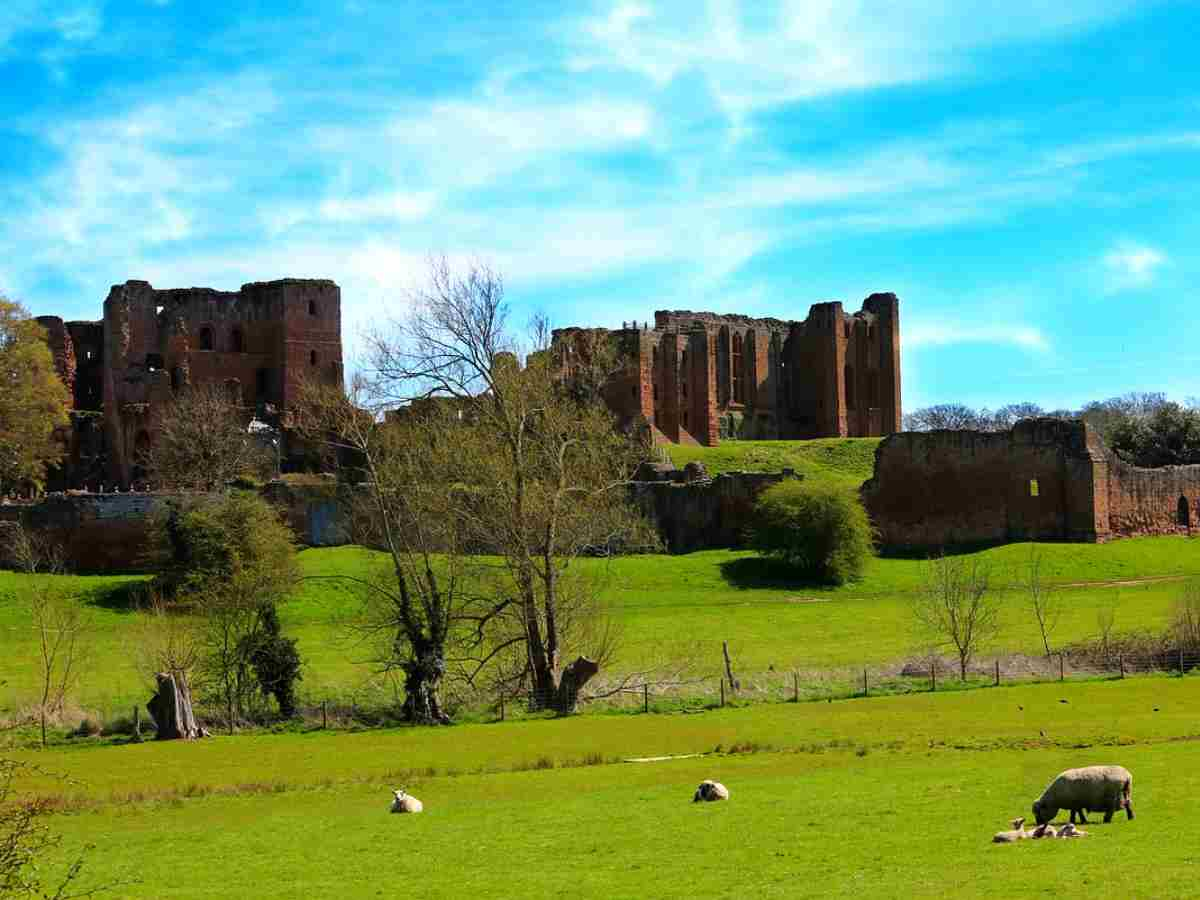
9. Leeds Castle, Kent, Southern England
Beautifully set on two islands on the River Len in Kent, Leeds Castle boasts a history that spans over 900 years. Originating as a Norman stronghold in 1119, it evolved into a royal palace, serving as the residence for six of England’s medieval monarchs, including King Henry VIII and his first wife, Catherine of Aragon.
Throughout its history, Leeds Castle has been rebuilt and renovated several times, resulting in a blend of architectural styles from different periods. Its rich history, coupled with its idyllic setting, has earned it the nickname “the loveliest castle in the world.”
Why Visit: The castle offers a journey through time with its beautifully furnished rooms, medieval gatehouse, and unique Dog Collar Museum. The surrounding gardens and parklands provide a peaceful escape into nature. Leeds Castle offers the ultimate in staycation experience in Kent.
Ownership and Management: Leeds Castle is currently owned and managed by the Leeds Castle Foundation.
How to Visit: 📍Leeds Castle, Kent: ME17 1PL
By Car: Leeds Castle is located near Maidstone in Kent, approximately an hour’s drive from London via A2.
By Train: Trains run from London Bridge station to Bearsted Station, followed by a shuttle service to the castle.
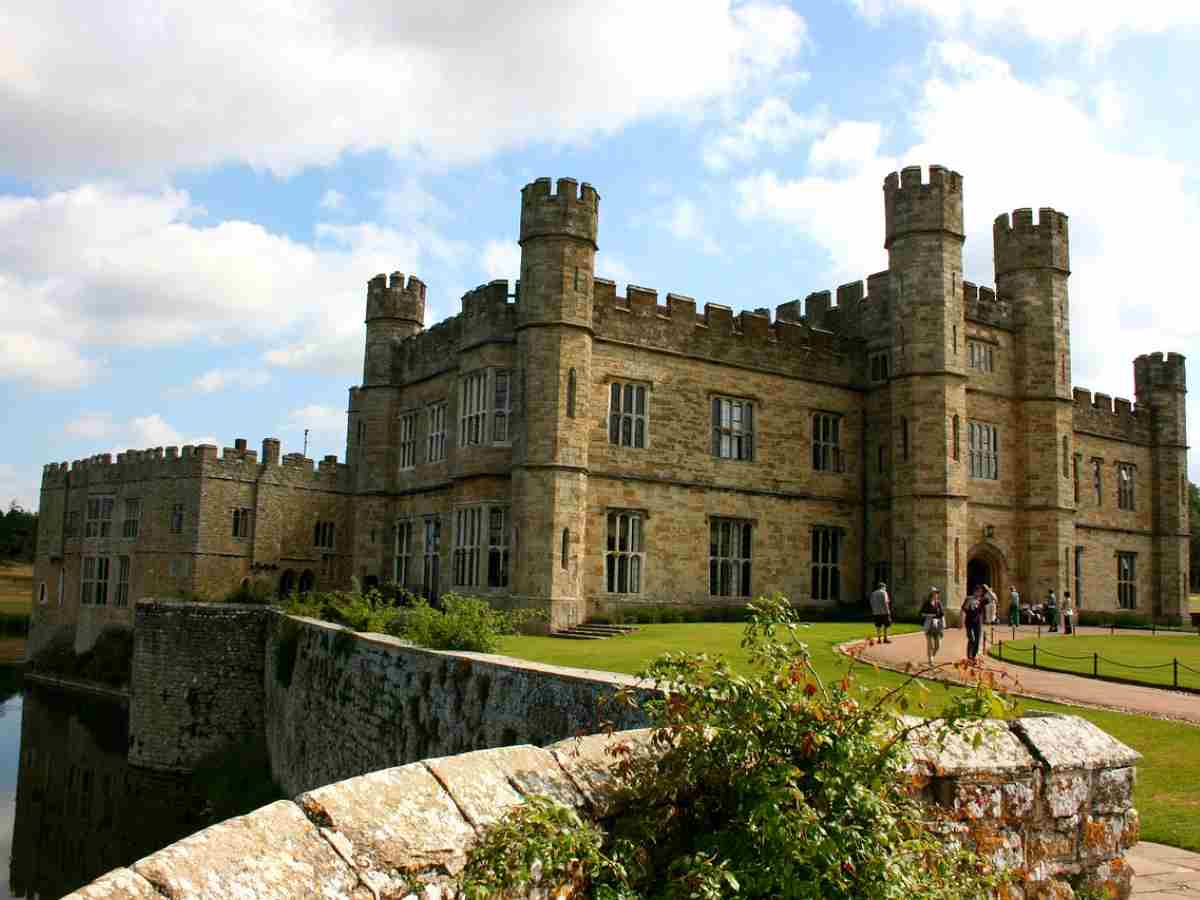
10. Lewes Castle, East Sussex, Southern England
Lewes Castle stands as a prominent Norman landmark with a rich history dating back to shortly after the Battle of Hastings in 1066. Constructed by William de Warenne, a close ally of William the Conqueror, the castle is one of the earliest Norman fortifications in England. Its two mottes, a rarity in English castles, and the remaining sections of the curtain walls, provide a glimpse into the Norman architectural and military prowess.
Why Visit: The well-preserved ruins, offer panoramic views of the surrounding town and countryside. The castle’s Barbican gate and the 14th-century Great Hall reflect the medieval grandeur of the fortress.
Ownership and Management: Lewes Castle is managed by the Sussex Archaeological Society.
How to Visit: 📍Lewes Castle, East Sussex: BN7 1YH
By Car: The castle is about an hour’s drive from London, via M23 and A23.
By Train: Hop onto the at London Victoria to Lewes, followed by a short walk to the castle.
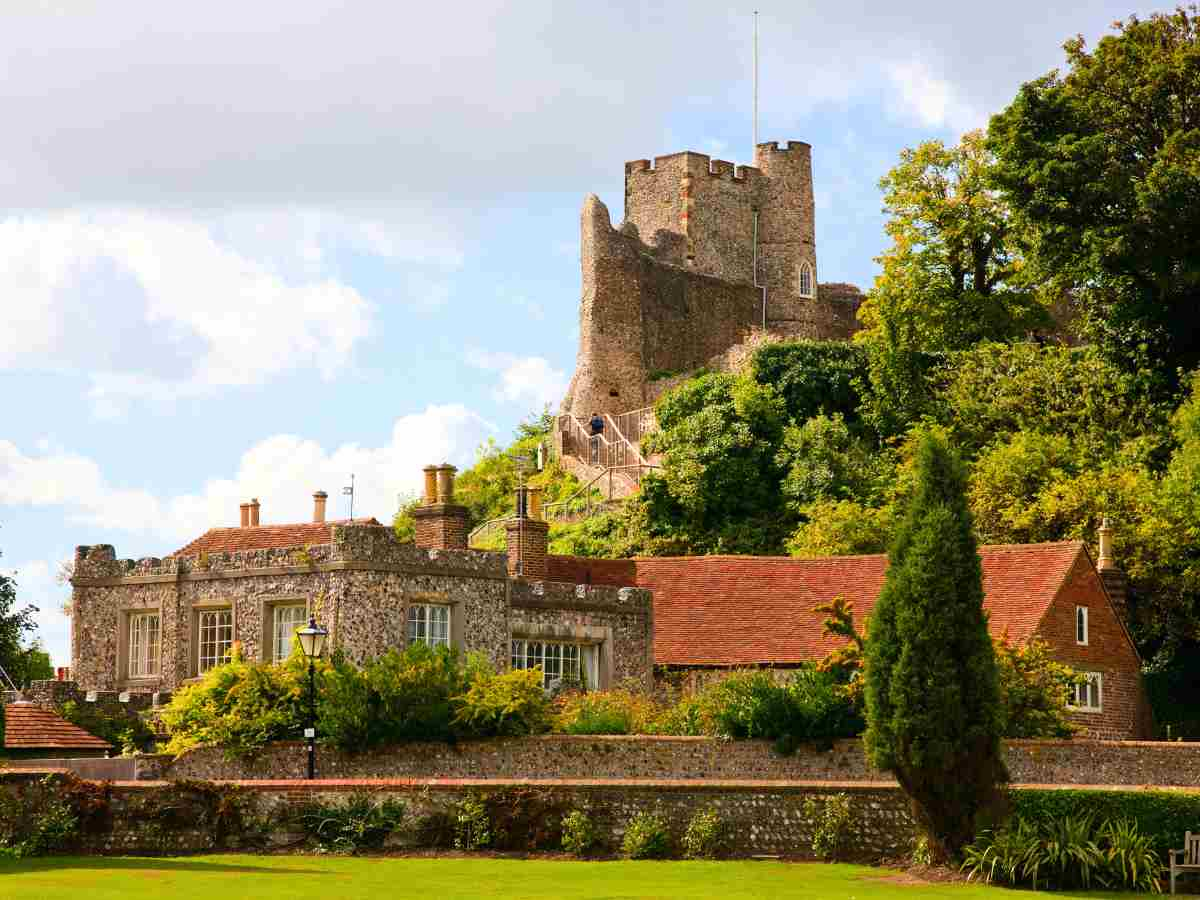
11. Rochester Castle, Kent, Southern England
Initially built on a Roman site soon after the Norman Conquest. the castle has evolved from a wooden structure to a substantial stone fortress, and is one of England’s most well-preserved and striking medieval fortresses. Throughout its history, Rochester Castle has played a significant role, notably during the Barons’ War of 1264.
Why Visit: Its massive Norman Keep, constructed in the 12th century offers panoramic vistas of the surrounding landscape from its top. The castle’s ruins provide a tangible connection to its turbulent past, allowing visitors to step back in time and explore the history of medieval England.
Ownership and Management: Managed by English Heritage.
How to Visit: 📍Rochester Castle, Kent: ME1 1SW
By Car: From London, approximately a 50-minute drive, via A13 and A2.
By Train: Take a train from London Victoria to Rochester, with the castle being a short walk from the station.
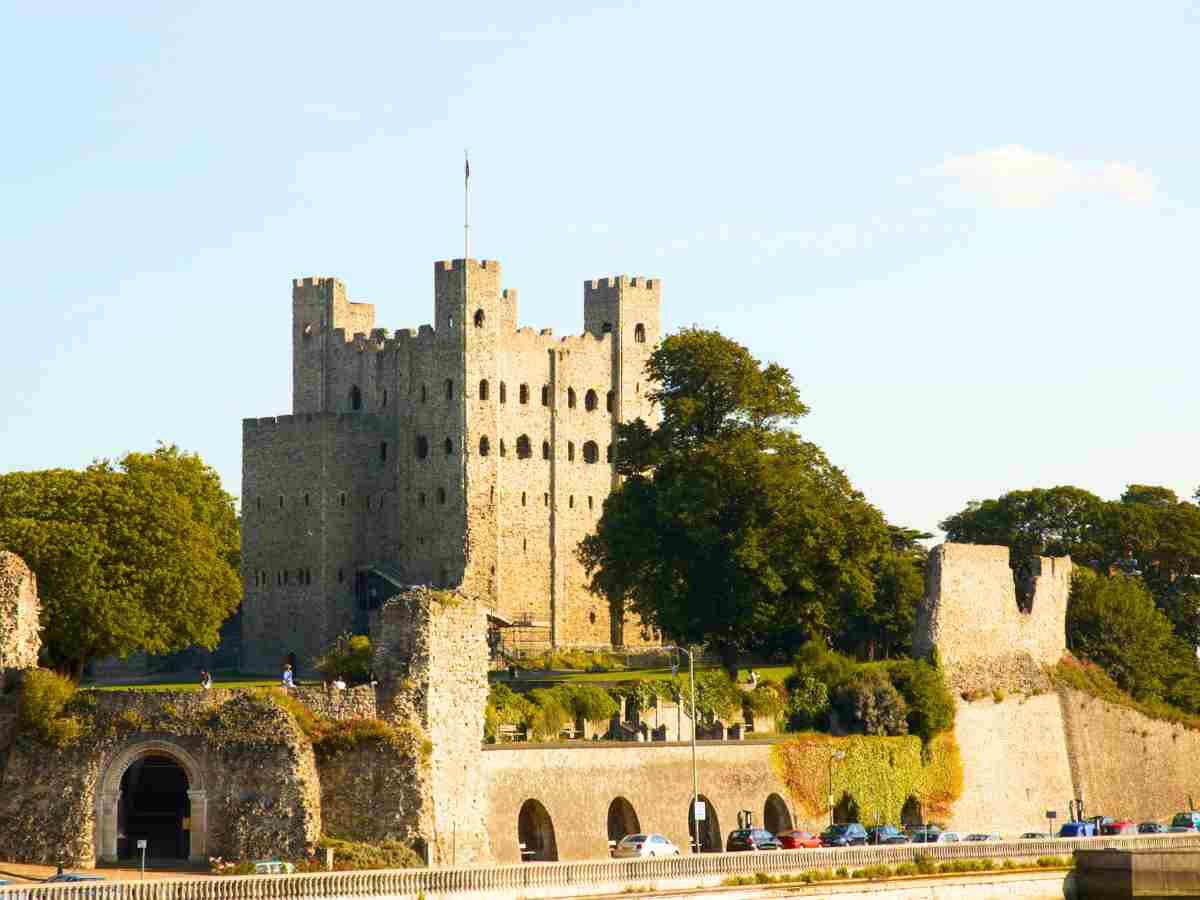
12. Scotney Castle, Kent, Southern England
Scotney Castle is a unique historical estate featuring two distinct structures. You’ll find the medieval 14th-century moated castle built in the 1380s alongside the newer 1830s country house built in Tudor Revival style. The house was added by Edward Hussey III, using sandstone from the old castle, creating a romantic landscape.
Why Visit: A unique opportunity to explore two eras of English architecture and garden design. The old castle, set on an island surrounded by a moat, provides a picturesque ruin perfect for exploration and photography. The newer house showcases Victorian life and design. The estate’s gardens are renowned for their beauty, especially during the spring and summer months when they bloom with rhododendrons and azaleas. The property also features a unique collection of artifacts and a tranquil landscape for a leisurely walk.
Ownership and Management: Managed by the National Trust.
How to Visit: 📍Scotney Castle, Kent: TN3 8JN
By Car: Situated near Lamberhurst in Tunbridge Wells, Kent, about a 1 hour and 30-minute drive from London, via A13.
By Train: From London Victoria to Tunbridge Wells, followed by a short taxi or bus ride.
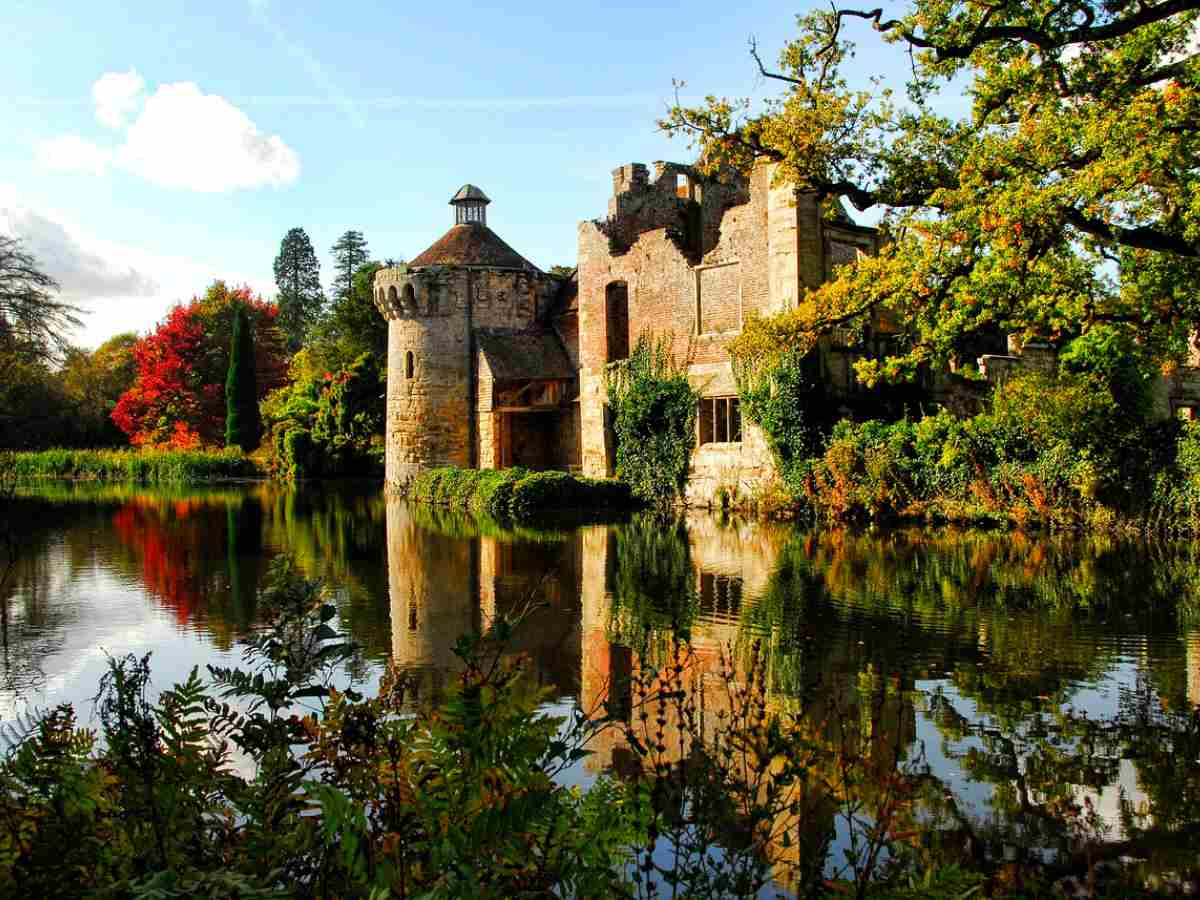
13. Southsea Castle, Portsmouth, Southern England
Built in 1544, and known historically as Chaderton Castle and Portsea Castle, it stands as one of the last fortifications commissioned by Henry VIII to defend the English coast. Southsea Castle played a significant role in the English Civil War and the Napoleonic Wars. In the 18th century, the castle suffered damage from a gunpowder explosion and underwent several reconstructions. A curved bastion was added and the eventual transformation into a military prison.
Why Visit: Visitors to Southsea Castle can explore its rich history and unique design. The castle’s strategic coastal location provides stunning views of the Solent, enhancing the visitor experience.
Ownership and Management: Southsea Castle is currently managed by the Portsmouth City Council.
How to Visit: 📍Southsea Castle, Portsmouth: PO5 3PA
By Car: A journey time of approximately 2 hours by car via A3.
By Train: From London Waterloo Station to Portsmouth, followed by a short bus ride.
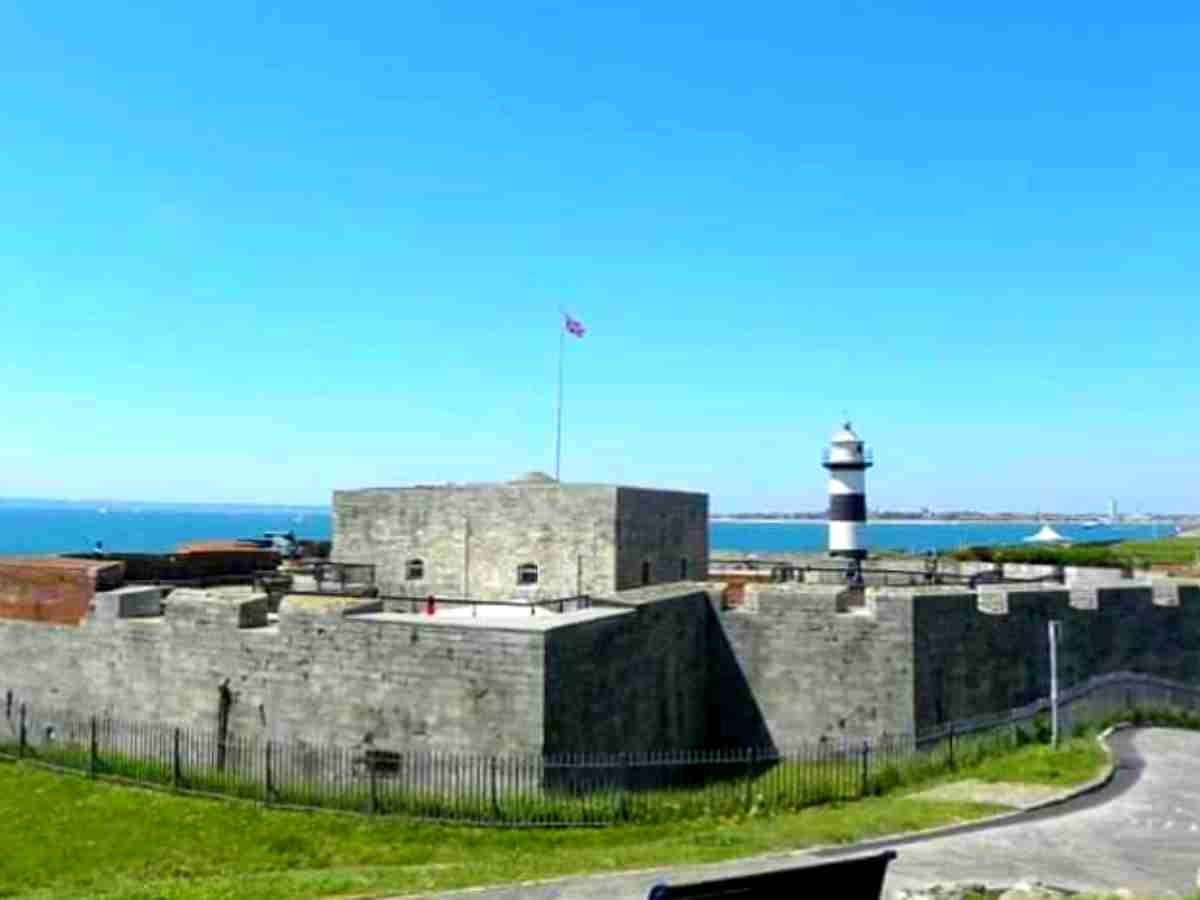
14. Tonbridge Castle, Kent, Southern England
Steeped in history, dating back to the Norman Conquest, Tonbridge Castle was built as an earth and timber motte and bailey castle by William the Conqueror in the 11th century, in southern England. The castle was later reconstructed in stone in the 13th century, and saw alterations and expansions over the centuries. Despite suffering damage and partial demolition, the gatehouse and some southern walls still stand, offering a glimpse into the castle’s formidable past.
Why Visit: Visitors to Tonbridge Castle can explore the well-preserved gatehouse and remaining walls, which tell the story of its rich history. The castle grounds, now a public park, provide a scenic and tranquil setting.
Ownership and Management: Tonbridge and Malling Borough Council currently manage Tonbridge Castle.
How to Visit: 📍Tonbridge Castle, Kent: TN9 1BG
By Car: Situated in the town of Tonbridge, Kent, and approximately an hour’s drive from London, via A13.
By Train: Direct trains run from London Bridge station to Tonbridge, making the castle easily accessible for day trips.
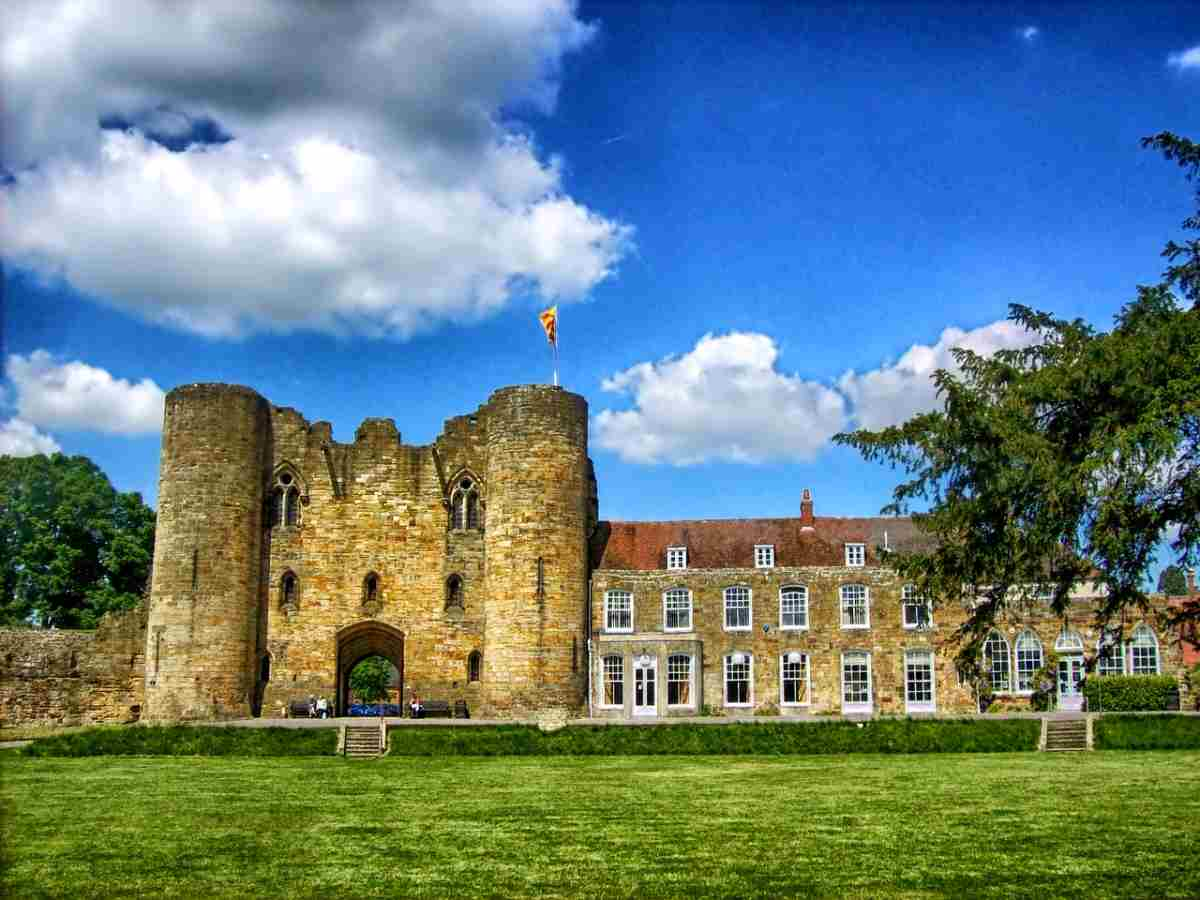
15. Upnor Castle, Kent, Southern England
Situated on the banks of the River Medway in Kent, Upnor Castle is a historic artillery fortress built in 1559 under the orders of Queen Elizabeth I, designed to protect the naval dockyard at Chatham. Despite its intended purpose, Upnor Castle is perhaps best known for its unsuccessful defense during the Dutch raid in 1667.
Why Visit: Visiting Upnor Castle offers a unique insight into the castle’s architectural design, a blend of medieval and Elizabethan elements. Visitors can explore its gun platforms, magazine buildings, and barrack rooms. The scenic location by the river and the charming village of Upnor add to the appeal, making it a picturesque and informative destination.
Ownership and Management: Managed by English Heritage.
How to Visit: 📍Upnor Castle, Kent: ME2 4XG
By Car: Located in Upper Upnor, Rochester, Kent with approximately a 50-minute drive from London, via A2.
By Train: Take a train from London Victoria to Rochester and then a short bus or taxi ride to Upnor.
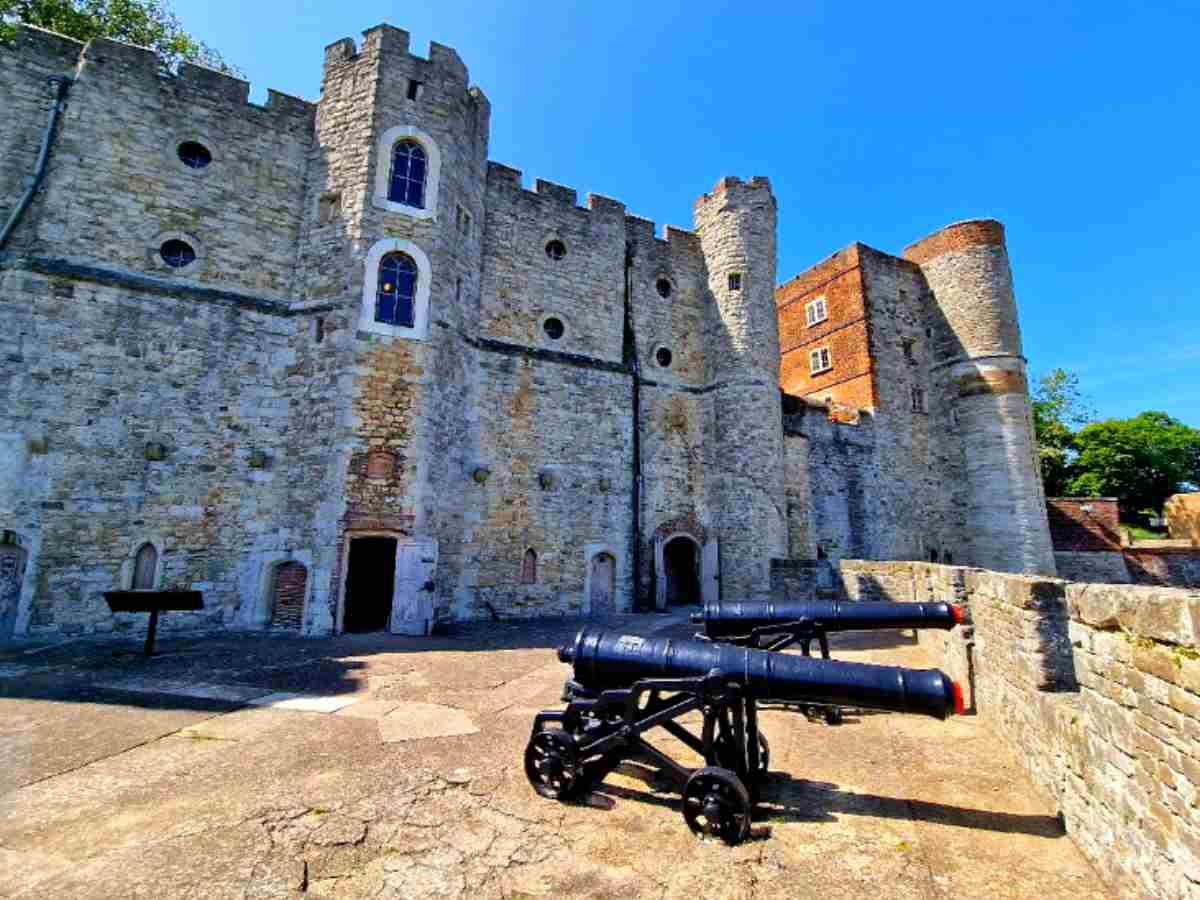
16. Walmer Castle, Kent, Southern England
Built in 1539 as an artillery fort for Henry VIII, it was designed to protect England against invasion from France and the Holy Roman Empire, and to safeguard the Downs anchorage off the English coast. Over the centuries, Walmer Castle evolved from a military fortification into a stately residence for the Lords Warden of the Cinque Ports. It has been the residence of many notable figures, including the Duke of Wellington and Queen Elizabeth the Queen Mother, each leaving their mark on the castle’s history and development.
Why Visit: Walmer Castle houses exhibits that tell the stories of its famous residents, particularly the Duke of Wellington. The gardens, developed during the Queen Mother’s residence, are a highlight, featuring a mix of formal and informal landscapes.
Ownership and Management: English Heritage manages Walmer Castle and Gardens.
How to Visit: 📍Walmer Castle and Gardens, Kent: CT14 7LJ
By Car: Situated in Walmer, Kent, along the south east coast of England. It’s an easy day trip with approximately a 2-hour drive from London, via M2 and A2.
By Train: Take a train from London Waterloo to nearby Deal, followed by a short bus or taxi ride.
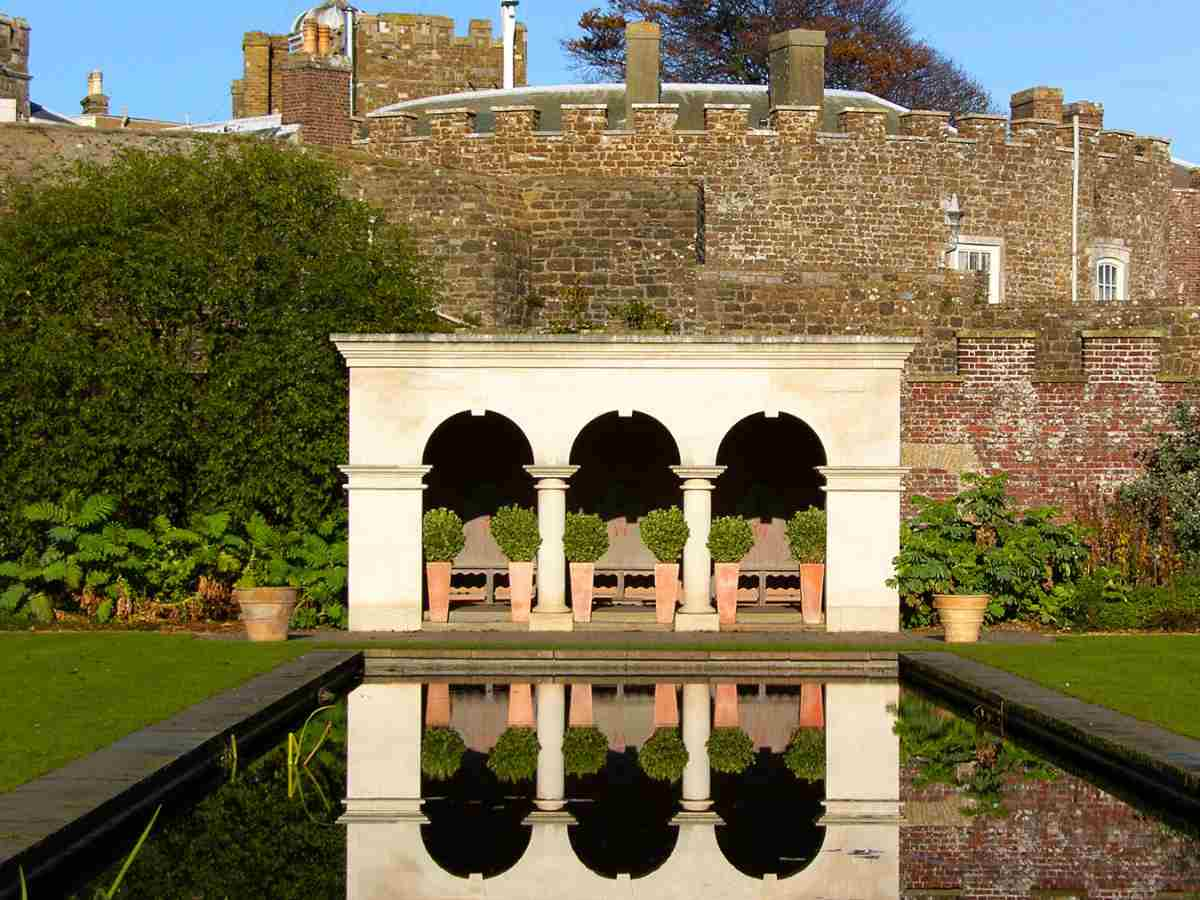
17. Warwick Castle, Warwickshire, England
Warwick is a monumental fortress with a history spanning over a thousand years. Originally built by William the Conqueror in 1068 as a wooden motte-and-bailey, it was later rebuilt in stone during the 12th century. The castle has witnessed significant historical events, playing roles in the Wars of the Roses and the overthrow of Edward II. Its evolution over the centuries has left a legacy of medieval military architecture, including impressive towers, ramparts, and dungeons.
Why Visit: Warwick Castle not only symbolizes the power of medieval English nobility but also the turbulent history of the British Isles, and is every bit a visit. The castle offers a journey back in time with its grand interiors, extensive armory, and wax figures depicting historical scenes. The beautifully landscaped grounds and gardens enhance the experience, providing a picturesque setting.
Ownership and Management: Currently managed by Merlin Entertainments, Warwick Castle is maintained as a major tourist attraction.
How to Visit: 📍Warwick Castle, Warwickshire: CV34 4QU
By Car: From London, with a journey time of approximately 2 hours by car via M1.
By Train: Board the train from London Marylebone to Warwick Station, which is about 1.6 kilometer (1 mile) from the castle.
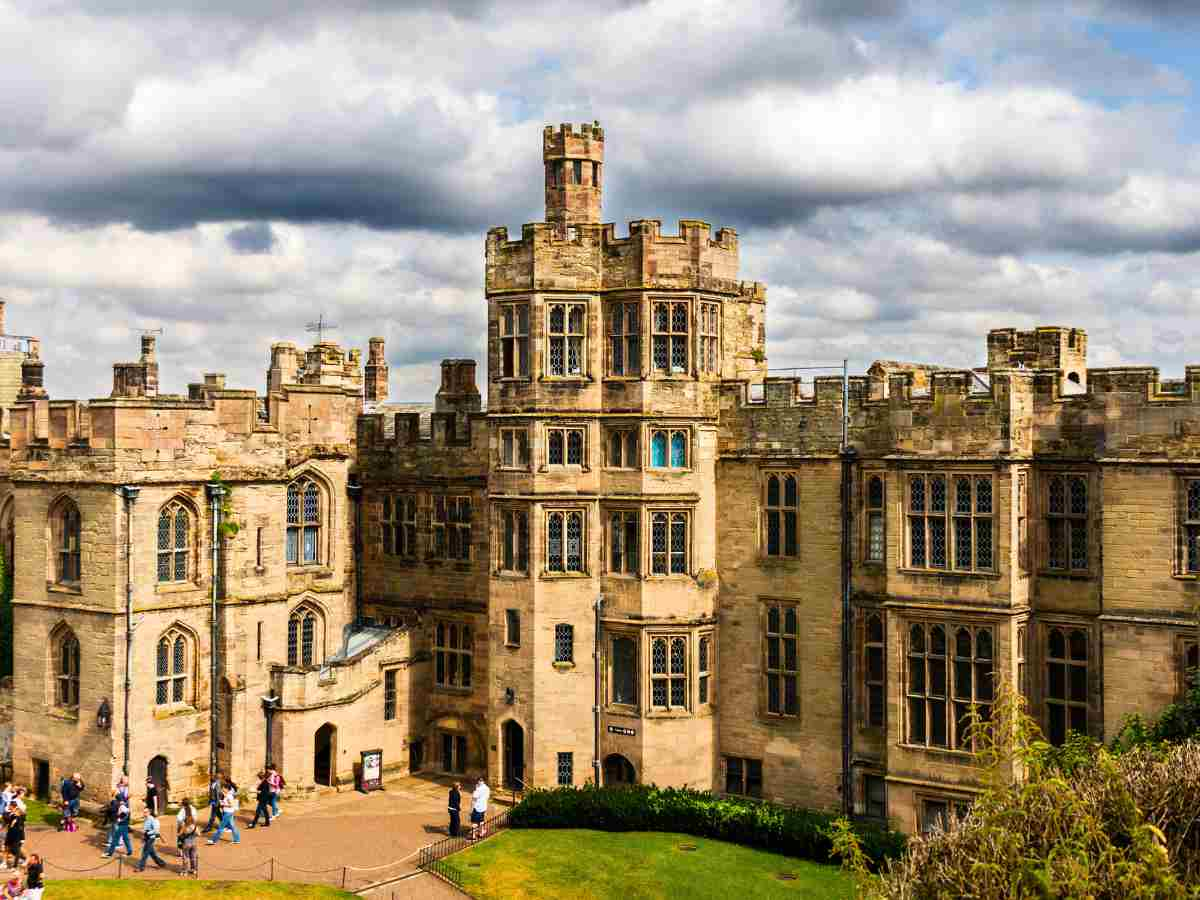
Special Features: In-Depth Explorations of Iconic Castles
In the compilation of Southern England’s fairytale castles, you might have noticed the absence of a few renowned names such as Carisbrooke Castle, Dover Castle, Hever Castle, and Windsor Castle. The reason behind this is quite special.
Each of these iconic castles is a story in itself, rich in history, architectural grandeur, and tales that span centuries. Recognizing their unique significance and the depth of their individual stories, I have dedicated an entire post to each of them. These posts offer a more intimate look into the castles’ past, their present standing, and the myriad reasons that make them not just structures of stone and mortar, but repositories of history and culture. These individual posts also offer practical tips for an all-round good journeys.
19. Dover Castle, Kent
Perched atop the iconic White Cliffs of Dover in Kent, Southern England, Dover Castle is known as the “Key to England” due to its strategic importance. This medieval fortress, with a history spanning nine centuries, was originally a motte and bailey castle built by the Normans. Over the years, it has seen significant developments, including the addition of the great Norman Keep by Henry II.
Dover’s Strategic Importance and How to Spend One Day here including Exploring the WWII Tunnels;
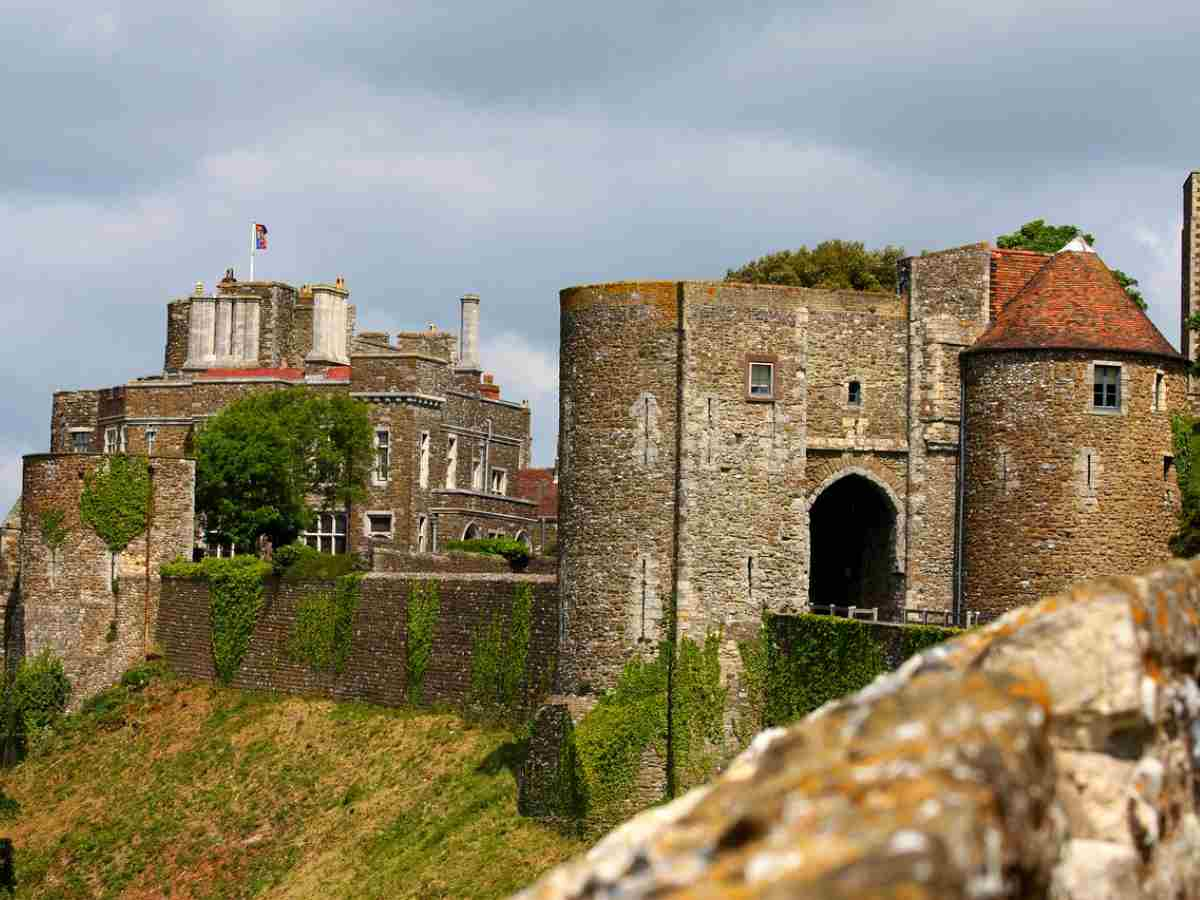
20. Hever Castle, Kent, Southern England
Hever Castle in Kent, England, holds a special place in British history as the childhood home of Anne Boleyn, second wife of King Henry VIII and mother of Queen Elizabeth I. The castle’s architecture and interiors reflect the grandeur of Tudor design, housing a collection of Tudor relics, furniture, tapestries, and even Anne Boleyn’s prayer books. Visitors can explore its well-preserved interiors, stroll through its 125 acres of stunning gardens, and lose themselves in the famous yew maze.
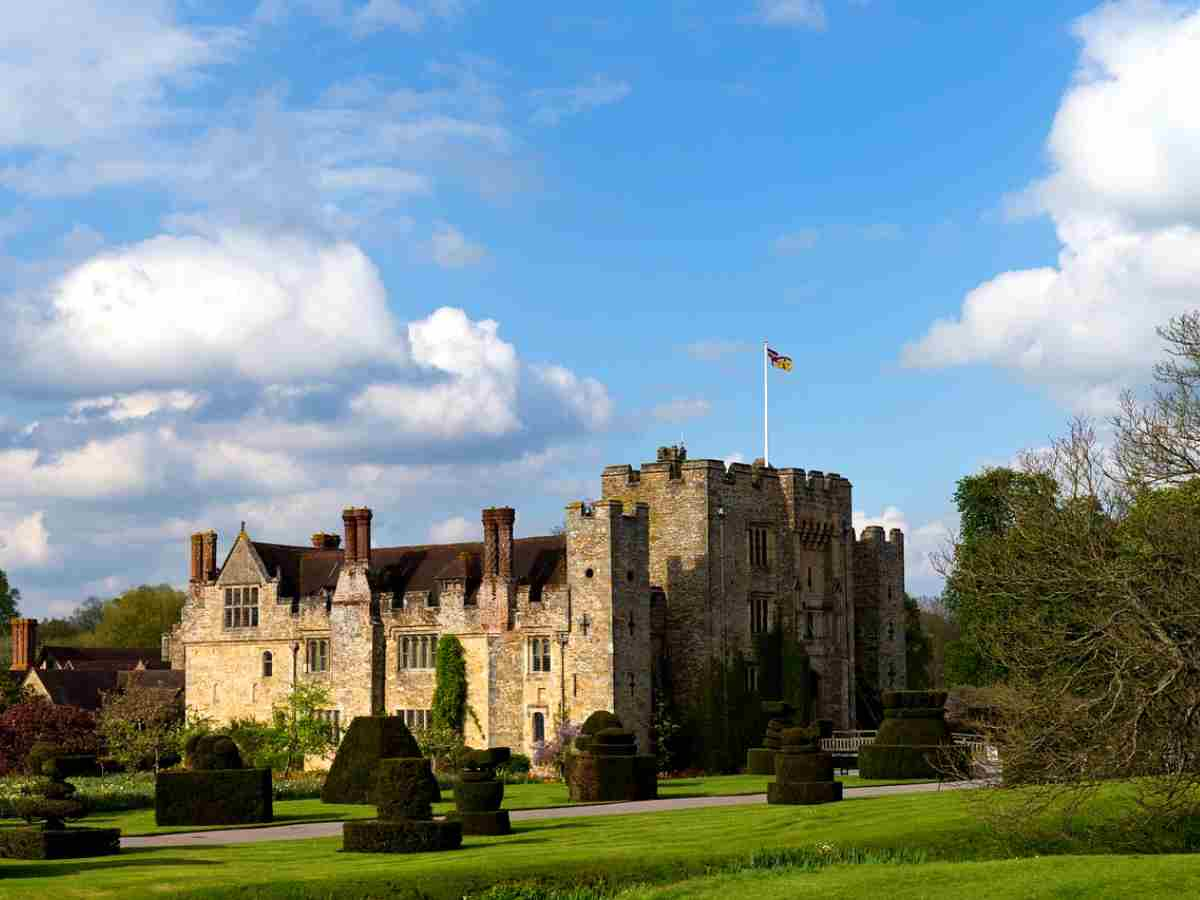
21. Windsor Castle, Berkshire, Southern England
Windsor Castle, located in Berkshire, is the oldest and largest occupied castle in the world to this day. Built by William the Conqueror in the 11th century, it has served as a royal residence for over 39 English monarchs. The castle’s architecture and interiors have been continuously updated by successive monarchs, reflecting changing tastes and royal needs.
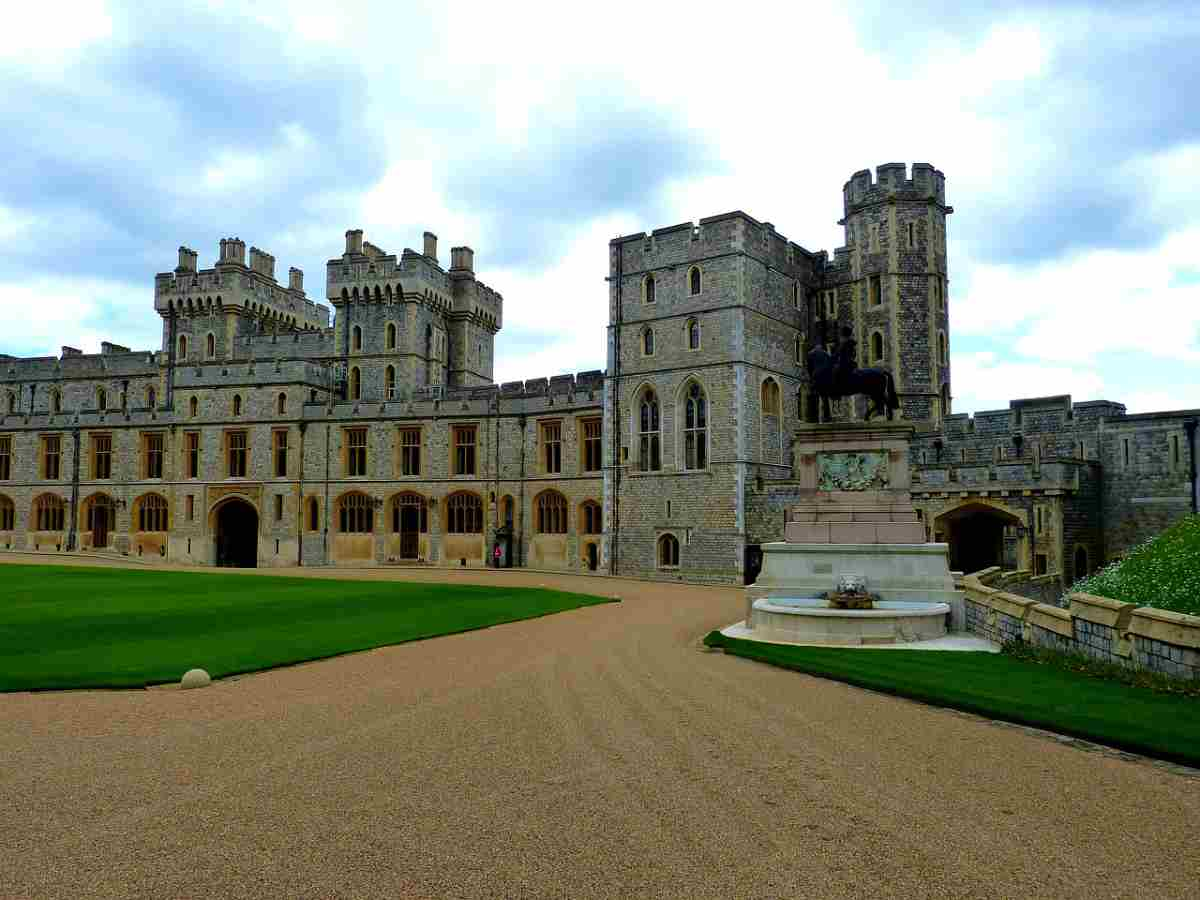
Bonus Castle!
The Tower of London
A historic fortress on the north bank of the River Thames, stands as one of the most iconic landmarks in the United Kingdom. With a history spanning nearly a millennium, it has served variously as a royal palace, a prison, an armory, and even a royal mint. Originally commissioned by William the Conqueror in the 11th century, the Tower has been continuously expanded and modified by successive monarchs.
Famous for housing the Crown Jewels and its role in the darker chapters of British history, including the imprisonment and execution of various historical figures, the Tower of London is not just a symbol of London’s past, but a testament to the evolution of English history.
Today, it is a UNESCO World Heritage site and one of the most visited historic sites in the world, attracting millions of visitors keen to explore its storied halls and bloody history.
How to Visit: The nearest station is Tower Hill, London.
READ: The Ultimate Guide to the Tower of London and the Best Ticket Options.
A Location Guide on Google Map of All the Castles Mentioned in this Article
- On the top left corner, click the arrow ➡ to open the frame;
- The frame opens, to show a list of icons and names of castles.
- Click on the castle you would like to know more about and see where it is located on the map.
- If you click on the icon on the map, Google provides you with additional information about the castle.
- When you finish, click the arrow on the top left to close the frame.
FAQs about the Best Castles in Southern England
Windsor Castle, located in Berkshire, is not only the largest castle in Southern England but also the largest inhabited castle in the world. It serves as one of the official residences of the British monarch and has a history that spans over 900 years.
The title of the oldest castle in Southern England is often attributed to Rochester Castle in Kent. Its keep, built in the early 12th century, stands as one of the best-preserved examples of Norman architecture in England.
The town of Rochester in Kent is notable for having two castles: Rochester Castle, famous for its well-preserved medieval keep, and Upnor Castle, a smaller Elizabethan artillery fort located on the opposite bank of the River Medway.
Though not in Southern England, Northumberland, in the North East of England, holds the distinction of having the most castles. This county is home to over 70 castle sites, reflecting its turbulent history as a border region between England and Scotland.
…as the deliberate escapist and mindful wanderer…
Each castle explored in this article is a gateway to a past rich with history, intrigue, and architectural splendour. These castles, set against the backdrop of England’s picturesque landscapes, offer more than just a day’s visit; they invite you into a world where history comes alive, and tales of knights and royalty resonate through the ages.
But the adventure doesn’t stop here. England’s charm extends far beyond its castles. From the iconic landmarks dotting the vibrant streets of London to the quaint and serene countryside of the Cotswolds, England is a tapestry of diverse experiences. And let’s not forget the culinary journey that awaits in London, where traditional English fare meets the flavours of the world.
Moreover, for those enticed by the allure of the gentle giants amidst the rugged landscapes and ancient legends, the wild highlands and castle ruins of Scotland beckon. They offer a stark, breathtaking contrast to England’s genteel scenery and storied fortresses, promising an entirely different realm of exploration.
So, whether you’re a history enthusiast, an architecture admirer, or a wanderer at heart, these castles are just the beginning. I invite you to explore all that England and Scotland have to offer. Embrace the allure of historic sites, lose yourself in the beauty of the countryside, and indulge in the culinary delights of the cities. England and Scotland together weave a storybook waiting to be read, and your next chapter is just a journey away.
Happy and Safe Travels Always, Wherever Travel Takes You, xx
Stay Connected with Timeless Travel Steps for the latest in our Travel News
